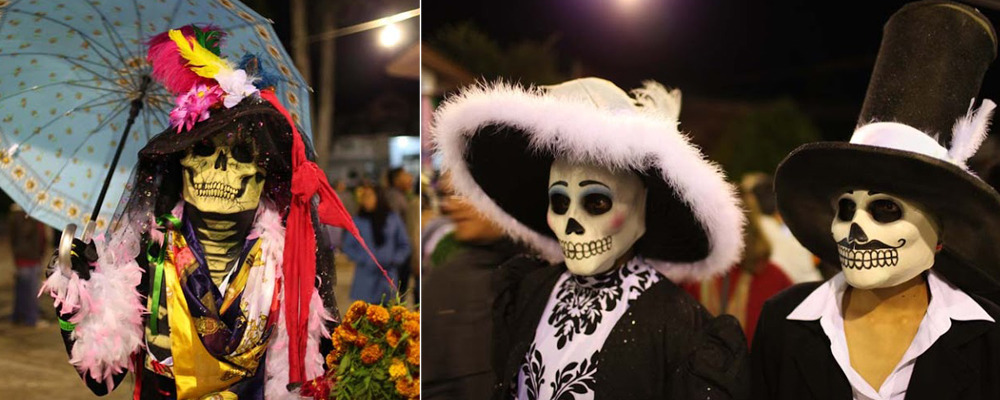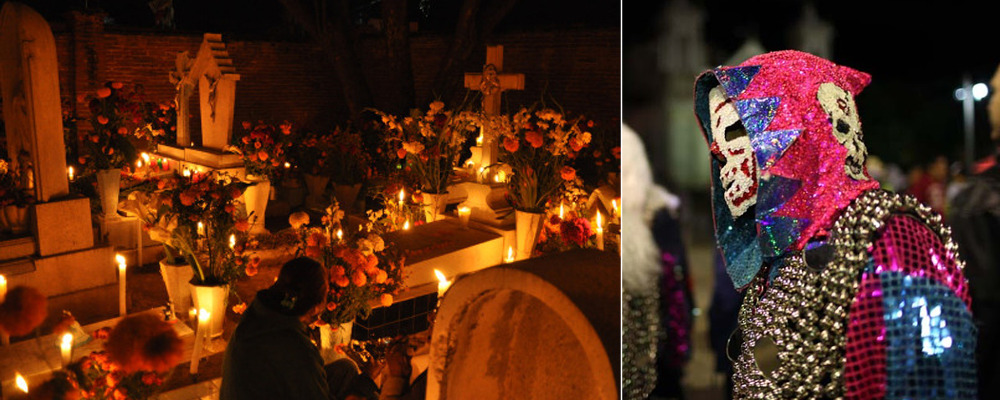Destination Oaxaca for Dia de Los Muertos
Emily Manthei
A cultural mash-up of Catholic saints days and pre-Colombian death rituals, Dia de los Muertos is a traditional Mexican holiday that’s been embraced by Latino cultures all over the world, including in the United States. But to experience Day of the Dead in its own cultural soil, head to Oaxaca, Mexico, where 16 indigenous pre-Spanish cultures have flourished since 1500 B.C., coming together for an exotic – if perhaps morbid – celebration of history and ancestry.
Muertos is rooted in the cultural belief that souls from the underworld acquire special permission to re-visit their living relatives once a year, when the celestial space between life and death disappears; in turn, the living relatives prepare for the souls of the departed with colorful shrines of marigolds arced into a symbolic doorway from the underworld, favorite foods, candles and celebratory decorations. The Catholic trio of feast days – All Hallow’s Eve (Oct. 31), All Souls Day (Nov. 1) and All Saints Day (Nov. 2) – coincide with the cemetery preparation day (Oct. 31), Dia de los Angelitos, or the day remembering dead children and infants (Nov. 1), and Todos Santos (Nov. 2), the day when departed adults are recognized. The massive, three-day party is complete with elaborate costumes, parades and music, ensuring that the dead are celebrated and remembered, not mourned. The beauty of Oaxaca’s colonial architecture and the spirit of a vibrant arts and crafts culture create the perfect setting for the carnival-like atmosphere of Dia de los Muertos.
Prepare for the event by learning to cook some favorite dishes of the departed, like Oaxacan mole (a chocolate-y hot sauce), nicuatole (corn jelly), and pan de muerto (the bread of death). The dead also seem to be great fans of Mexico’s particular brand of stone-ground chocolate with spices – pick some up just in case. One-day cooking classes with Chef Pilar Cabrera of Oaxaca’s La Olla Restaurante are available from Casa de los Sabores and include a five-course meal and mezcal tasting in addition to your access to seasonal ingredients and secret family recipes.
Pick up some festive candy skulls, mezcal, pan de muerto (if you haven’t mastered baking it yet) and marigolds at Oaxaca’s central square, Zocalo. If you’re lucky you may even run into a Comparsas, a local theater piece depicting the return of the dead. Finally, head to Panteon San Miguel, Oaxaca City’s central cemetery or Panteones Viejo y Nuevo, the two cemeteries in the nearby Oaxaca-province village of Xoxocotlan. There you’ll see thousands of candles lit amidst the elaborate shrines dedicated to the memories of lost loved ones. Offer your marigolds and bread in respect to the families in remembrance among the altars and they’ll probably let you take a photo of their set-up and tell you stories of their loved ones who don’t seem to be resting, but, Oaxacans will assure you, are still at peace.
DO:
Explore the most lasting legacy of the Spaniards in Oaxaca, their enduring architecture. The Oaxaca Museum of Culture, housed in former monastic buildings attached to the Church of Santo Domingo de Guzman, is worth a visit for the splendor of the 16th century Baroque architecture alone. Inside the museum, Mesoamerican treasures abound, like the gold, silver, stone and bone – yes, bone! – carvings found inside a Mixtec tomb at Monte Albán. Then, trade the museum experience for an excursion to the archeological site of Monte Albán, where you can see preserved Zapotec sites and some of the best carvings in Latin America.
Stroll up Calle Alcala, a cobblestone pedestrian thoroughfare also known as the Andador for some people-watching and gallery crawling. Oaxaca’s Museum of Contemporary Art is housed in a colonial building along the route and is dedicated to Mexican and international modern art. Conferences and lectures on contemporary photography in Oaxaca are on-going in October.
Get some exercise and take the hike up the Cerro del Fortin, a pedestrian hill leading to a stairway lined with houses and small shops. At the top is Guelaguetza Stadium, an excellent vantage point to take in the rest of the city and see where people are gathering.
EAT:
Start the day with Oaxaca’s best cup of coffee at Cafe Volador, an intimate spot near Parque Conzatti where artists drop by for a coffee and a chat and friendly locals linger al fresco. Café Bruja, also known for great coffee (you can find a branch on the Alcala), is another casual spot for a quick morning bite and free wi-fi. But the more brazen visitor will skip straight to Mexican street foods and local fruit, freshly ground chocolate, Oaxacan cheese and dried chillies at the Mercado Juárez.
For local recipes with a Spanish flair, check out Casa Oaxaca. This rustic restaurant offers fantastic views (make sure to ask for a rooftop table) and fantastic food. A five-course meal tops out at $32, leaving you plenty of cash for the inevitable mezcal tasting later on. A more modern take on Mexican cuisine at Los Danzantes Oaxaca provides peaceful outdoor seating and oozes with ambiance.
DRINK:
Although Oaxaca is less known for it’s nightlife scene than its folksy arts and crafts, that doesn’t mean you can’t find a good cocktail or a place to dance the night away. Sip on local mezcal varieties at Los Amantes, a postage stamp of a bar that holds the history and knowledge of mezcal at its fingertips. Suited for the serious aficionado, magazines like Bon Appetit and Latin Lover can’t get enough of this one-of-a-kind Oaxaca Mezcaleria. For traditional Latin dancing (take a salsa class on Thursday to prepare for the weekend) with live bands nightly, check out Candela. If new-school Mexican cumbia and contemporary dancing with hip DJs is more your thing, Cafe Central is your venue. You can expect a Dia de los Muertos themed set to outlast the cemetery parties here.
STAY:
Housed in a 16th-century convent, Quinta Real Oaxaca is within walking distance of the Zócalo and is the must stay hotel in Oaxaca. With a variety of restaurants, bars and event spaces, you’ll no doubt find both places to sit and relax and ones in which to join the party. The top choice for modern, understated elegance is Hotel Azul Oaxaca. Steps away from the Ethnobotanical Gardens, you’ll be free to roam in the early mornings after a peaceful night’s sleep. B&B charmers Casa de las Bugambilias and Casa Oaxaca both provide a more personalized, home-stay atmosphere with local folk art and charm as their selling points. Indulgent Mexican breakfast is included.
For more information on Dia de Los Muertos, click here.


